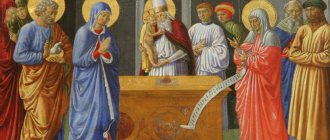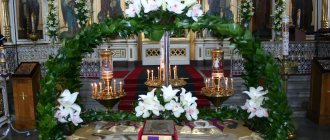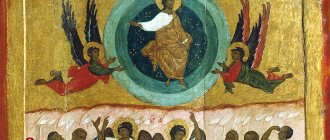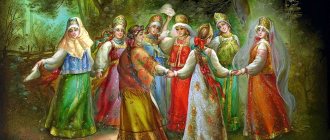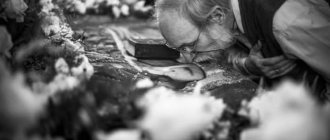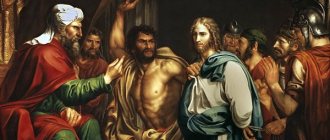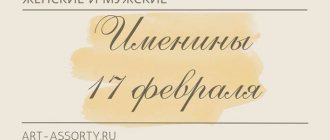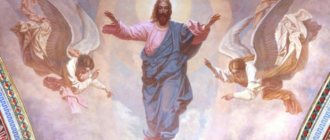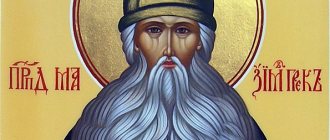The days following the holiday of Easter are called post-celebration. The period lasts 39 days, and on the 40th day the church celebrates the Ascension. In 2022, the celebration falls on June 10. And on the 9th the celebration of Easter will take place.
So far, holiday services have been held in all churches, Easter chants have been sung, and now they will no longer be heard until next Easter. On the 9th you can still greet each other with the words “Christ is Risen!” Believers also read prayers of gratitude to the Savior for bringing us closer to God, and now physical death means for the righteous birth into eternal life.
What is Passover?
The main church holidays (Easter and the Twelfth Feasts, except the Entry of the Lord into Jerusalem), in addition to the day of the holiday itself, have periods of pre-celebration and post-celebration - that is, the time of preparation for the holiday and the time of celebration after.
Giving (from Greek απόδοσης - “giving, returning”) of Easter or another holiday is the last day of the after-feast. On the day of the holiday, a solemn service is performed with prayers and chants that were sung on the day of the holiday itself. Thus, the service of Giving almost completely coincides with the services of Bright Week, which occurs immediately after Easter (in 2022, from April 24 to April 30 inclusive).
If we draw an analogy with worldly holidays, we can say that January 13 (New Year according to the old style) is the conditional end of the New Year holidays, i.e. a kind of New Year's “giving back”.
Holiday traditions
The main tradition on the day of Easter is attending a solemn service, which is so reminiscent of Easter. In 2021 it falls on June 9. The service on this day is always very beautiful, the priests wear festive vestments and go out into the middle of the church with candles and a censer. Easter chants are especially joyful for all believers. The final note is the end of the liturgy with the main Easter exclamation “Christ is Risen!”
Also on the day of dedication, an Easter religious procession is required. After the liturgy, the shroud will be taken back to the simulated tomb. During the entire period of the post-feast, she was in the altar on the throne.
Until Trinity, Orthodox believers are exempt from some prohibitions: for example, they do not bow to the ground, and there is no fasting on Wednesdays and Fridays, as is usually the case.
History of giving
The day of the Easter holiday was the last day of the life of Jesus Christ on earth, when the risen Lord appeared to his disciples to say his last words about the kingdom of heaven. We find accounts of the appearances of the Risen Lord in the forty-day period from Easter to the Ascension in all four evangelists:
“According to John, Jesus first appeared to the disciples on the very day of the Resurrection, when the doors were locked; then - after eight days, when Thomas also believed. Then, when they were thinking of going to Galilee and not all were gathered together, but some of them were fishing on the Sea of Tiberias, then the Lord appeared to only the seven who were fishing. What Matthew speaks of happened afterward, precisely when what John narrates happened first, for he often appeared to them over the course of forty days, first coming and then leaving again, but not always and not being present with them everywhere.”
St. John the Theologian writes here in particular detail; the last 21st chapter of the Gospel is completely devoted to the description of the third appearance of the Savior, which occurred on the Sea of Tiberias. This time the Lord not only appeared before the disciples, but also shared a meal with them, although, after His Resurrection, He no longer needed reinforcement of bodily strength, but did so for greater assurance, to show that He was resurrected in the same flesh , in which he suffered on the cross. At the same time, one of the most significant events in the history of the nascent Church of Christ happened, with the commission of St. to the Apostle Peter about concerns for the general church dispensation:
“When they were dining, Jesus said to Simon Peter: Simon the Jonah! Do you love Me more than they? Peter says to Him: Yes, Lord! You know I love you. Jesus says to him: Feed my lambs. Another time he says to him: Simon the Jonah! Do you love me? Peter says to Him: Yes, Lord! You know I love you. Jesus says to him: Feed My sheep. He says to him for the third time: Simon the Jonah! Do you love me? Peter was saddened that he asked him for the third time: Do you love Me? And he said to Him: Lord! You know everything; You know I love you. Jesus says to him: Feed My sheep. Truly, truly, I say to you, when you were young, you girded yourself and went where you wanted; and when you are old, you will stretch out your hands, and another will gird you and lead you where you do not want to go. He said this, making it clear by what death Peter would glorify God” (John 21:15-19).
The next appearance of the Risen Lord, according to the interpretation of Bl. Theophylact of Bulgaria, described by St. Evangelist Matthew, when He commanded His eleven apostles to gather in Galilee and commanded them to go to world preaching. Here the Savior makes a solemn promise about His inseparable presence in the Christian race: “And behold, I am with you always, even to the end of the age. Amen" (Matt. 28:20).
Part 4
Before the start of the liturgy, the usual prayers are not read, but after three times of worship before St. throne with the words: “God, cleanse me, a sinner
", the priest and deacon kiss the throne.
The deacon silently takes the blessing from the priest, goes out in front of the royal doors to his usual place and exclaims: Bless, lord.
The priest pronounces the opening exclamation of the liturgy: Blessed is the kingdom of the Father, and the Son, and the Holy Spirit, now and ever, and unto ages of ages.
, and creates, as always, the cross over the throne with the Gospel.
Lik answers: Amen
and then Vespers begins with the reading of the opening psalm 103.
At this time, the priest, with his revealed head, reads the Lamp Prayers
, starting with the fourth, for the first three are then read during the proclamations of the small litanies between the antiphons of the kathisma.
After the opening psalm, the Great Litany is pronounced with the usual final exclamation of the priest: “ For all glory is due to You.”
..." and then the 18th kathisma will be sung:
"To the Lord, never shall we grieve
..." (The reader ends each Glory by reading Alleluia three times).
After each antiphon, or each “Glory
,” the deacon pronounces the Small Litany.
During the litanies, the priest secretly reads prayers, the first three from among the lamp litanies, and then proclaims: after the first small litany - “For Thy is the kingdom, and the power, and the glory
...” after the second -
“For Thou art a good and philanthropic God
... ”after the third:
“For You are our God, the God of mercy and salvation
...”
During the verse of the kathisma, the Presanctified Lamb is transferred from the throne, where he is usually now in the bread-bearer, to the altar. In ancient times, the bread bearer was on the altar in the so-called “Offering”. Therefore, the charter prescribes: “At the beginning of the verse, the priest goes into the offering and, taking the Pre-sanctified Bread from the bread-bearer, with great reverence places it on the St. paten, then poured into St. cup of wine and water, then he censes the star and shrouds over the censer and covers the paten and the cup with them, without saying any prayers to the proskomedia, but only saying: Through the prayers of the saints, our fathers, Lord Jesus Christ our God, have mercy on us
, for the Holy Gifts have already been consecrated. At present, the bread-bearer is usually not on the altar, but on the throne, and therefore the Presanctified Lamb is first transferred from the throne to the altar. At the beginning of the first antiphon, the priest places the Gospel on the upper part of the throne, opens the antimension, places the paten on it and places the Presanctified Lamb on it from the bread-bearer. During the second antiphon, a priest with a deacon holding a candle in his hand censes the throne with the Lamb lying on the paten, walking around it three times. During the third antiphon, the priest, having bowed to the ground to the Holy Gifts, raises the paten with the Holy Lamb on his head and, going around the throne to the right, transfers it to the altar, pours wine and water into the chalice and covers the sacred vessels, as indicated above, with coverings and censes the Holy Gifts. Then he returns to the throne, folds the antimension and places St. on it. Gospel.
At the end of the kathisma and the third small litany, the singing “Lord, I have cried”
” and stichera, of which there are always ten at the Liturgy of the Presanctified Gifts.
On “Glory, and now
” the royal gates are opened and the evening entrance with the censer takes place. But in those cases when the Gospel is read at the Liturgy of the Presanctified Gifts, as happens on holidays and the first three days of Holy Week, the entrance is made with the Gospel. If the Liturgy of the Presanctified Gifts is performed by the bishop himself, the entrance is always performed with the Gospel.
Upon entering and the usual singing of “Quiet Light
"
The prokeimenon
from the Triodion is pronounced and two proverbs are read. In St. The first proverb of Lent is always from the book of Genesis, as depicting the fall of man and its disastrous consequences, and the second - from the book of Proverbs - about Divine wisdom, which repentant sinners should seek if they want to truly correct their sinful lives and please God. During the reading of the proverbs, the royal doors are closed.
At the end of the first paremia, the royal doors are opened and the reader pronounces and the second prokeimenon, also from the Triodion, is sung by the face. After singing the prokeemna, the deacon, turning to the priest (and during the bishop’s service, the protodeacon to the bishop) proclaims: “Command
".
The priest (or bishop), taking in both hands a censer and a candle on a candlestick (and the bishop is a trikirium), stands in front of St. meal, in vain to the east and, signifying the cross, says: “Forgive Wisdom
,” thereby arousing those praying to special attention and reverence.
Then, turning to the west to the people, he says: “The light of Christ enlightens everyone
,” as if showing that the forefathers and prophets, whose writings have now been read and will still be read, were enlightened by the same God's light, which has now appeared in the world through Him The Redeemer, foretold by them, enlightens everyone. This is usually done with the royal doors open, and all those praying are thrown prostrate to the ground. Historically, this sacred rite is explained by the fact that in ancient times, on the days of St. The catechumens preparing for baptism were overshadowed by lighted candles before they left the church, as a sign of the gracious light of Christ, which they should receive in the Holy Spirit. baptism at the end of Lent (on Holy Saturday, usually). Then follows the reading of the second proverb from the book of Proverbs in a row.
Sometimes at the Liturgy of the Presanctified Gifts, in addition to the two proverbs of the Triodion, the proverbs of the holiday are also read. This happens at the Presanctified Liturgy on the feasts of great saints, if these holidays happen on Tuesday, Wednesday, Thursday, Friday and Saturday of the 2nd, 3rd, 4th and 5th weeks of Great Lent - Finding of the Head of St. John the Baptist on February 24 and 40 martyrs on March 9, as well as on temple holidays. The proverbs of the holiday are read on the eve of the Feast of the Annunciation of the Most Holy Theotokos on March 24, if this eve falls on Wednesday or Friday, when the Presanctified Liturgy is served. In general, you need to know that Vespers, combined with the Liturgy of the Presanctified Gifts, performed on the eve of the holiday, already refers to the day of the holiday itself, which is why the stichera of the holiday are sung and its proverbs are read. In such cases, the All-Night Vigil for the holiday begins not with Vespers, but with Great Compline.
After reading the proverbs, the priest says to the reader: “Peace be upon you.”
“, and the deacon:
“Wisdom
.”
This is followed by the singing of the touching verses of Psalm 140 with a refrain for each verse: “May my prayer be corrected
...”
According to the charter, the reader or priest, standing in front of the royal doors, sings these verses, and the choir sings the chorus after each verse. Nowadays, the custom has been established almost everywhere that these verses are sung in the middle of the church by three singers, and the choir sings a chorus to each verse. The order of this chant is as follows:
The singers sing verse 1: Let my prayer be corrected, as incense before You, the lifting of my hand, the evening sacrifice
.
Lik sings the same verse, which also serves as a chorus.
The singers sing verse 2: Lord, I have cried to You, hear me, listen to the voice of my prayer, sometimes I will cry to You
.
The face sings the same refrain: May my prayer be corrected
:
The singers sing verse 3: Set, O Lord, a guard over my mouth, and a guard over my mouth.
Face - chorus - May my prayer be corrected
:
The singers sing verse 4: Do not turn my heart into words of wickedness, do not bear the guilt of sins.
Face - chorus - May my prayer be corrected
:
After this, the singers sing the first half of the first verse: May my prayer be corrected, like incense before You
:, and the face finishes the second half:
Lifting of my hand, evening sacrifice.
Thus, this singing is similar to the singing of the great prokemena. In the singing books it was called the “Great Prokemne”. During this singing, the priest, standing in the altar before St. having eaten the meal, having taken the censer with incense, he censes. While singing the last verse: “Do not turn away my heart
…” the priest goes to the altar, and the deacon, rising from his knees, follows him.
The priest censes in front of the altar three times and gives the censer to the deacon, who, standing in front of the altar, censes until the end of the singing: “ Let him be corrected
...” The priest, returning to the throne, kneels before him, also until the end of the singing.
During the singing of “Let Him Be Corrected,” the Charter instructs the people and choirs (choirs) to either rise from their knees or kneel again. Those who sing, while singing, stand without bending their knees. Each time they finish their singing, they kneel. Thus, at the very beginning of the singing, everyone, except the reader or three singers singing: “Let him be corrected
...” and the priest censing in the altar, are all on their knees.
Then the singers kneel, and everyone in the temple stands up and sings the chorus: “Let it be corrected
...” When singing for the last time:
“Let it be corrected,
” everyone, not excluding the reader or singers and the priest, kneels. The charter instructs the chorus to be sung by the right and left faces alternately, and together with the face and all the people standing on that side, and it is ordered to stand without bending the knees, not only to the face that sings, but also to the people standing on the other side of the face that sings. It is important to note the Typikon’s instructions in the article “On Bowing” that the Rule commands many things to be sung during worship, except for singers, and for the people. In many liturgical books this is clearly indicated by the words: “people speak.”
After singing "Let him be corrected"
“It is indicated to make three great bows, at which the prayer is read: “
Lord and Master of my life
.”
After great bows, on the days of remembrance of great saints and on the days of temple holidays, the prokeimenon is pronounced and the Apostle and the Gospel are read. During Holy Week, one Gospel is read. At the same time, it is indicated to open the royal doors. Consequently, according to the Charter, they do not open to the singing of “Let it be corrected,” but in practice it has firmly become a custom to open them.
After the reading of the Gospel or after great bows, if the Gospel has not been read, the usual order of the liturgy follows: the special litany, the litany of the catechumens
and
two small litanies of the faithful
.
During the special litany, the same secret prayer is said as during the full liturgy, and the Antimins unfolds in the same way as during the full liturgy. The recitation of the funeral litany, as happens at a full liturgy, is considered by many to be inappropriate at the Liturgy of the Presanctified Gifts, since this liturgy cannot be considered a propitiatory sacrifice for the dead, but some consider this commemoration acceptable, like any other prayer. During the litany of the catechumens, as usual, the entire Antimins is spread out and the primate, at the final exclamation, marks a cross on the Antimins with his lip, kisses it and places it on the right side of the Antimins at the top. Since in ancient times among the catechumens there were those who were preparing to receive St. on Holy Saturday during Holy Week. baptism, then from the Wednesday of the veneration of the cross a special litany is said about these “our brothers preparing for holy enlightenment” with a special secret prayer for them and the final exclamation of the priest: “For you are our enlightenment
...” At the next two small litanies, special secret prayers are read, and The second litany concludes with a special cry from the priest:
By the gift of Thy Christ, with whom art thou blessed, with Thy Most Holy and Good and Life-giving Spirit, now and ever, and unto ages of ages.
Then, instead of the Cherubim, a special chant is sung:
Now the powers of heaven invisibly serve with us: behold, the King of glory has entered, behold, the secret sacrifice has been completed, let us draw near with faith and love, so that we may be partakers of eternal life: Alleluia, Alleluia, Alleluia
.
At the beginning of this singing, the royal doors open. The deacon censes St. the meal, exactly the same, three times, and the holy offering, the altar. In practice, the entire altar is censed, but the censer does not go out to the pulpit, and there is no censing of the iconostasis, faces and people. The prayer of the Cherubic Song is not recited, but during the incense, the priest can read the 50th Psalm to himself. Then, as at the full liturgy. The priest and deacon, having bowed three times, read: “Now the powers of heaven
..." The deacon ends each time with the words:
"By faith and love let us approach
..." This, like the Cherubim, is read three times, after which, having kissed the throne, the priest and deacon go to the altar in order to begin the Great Entrance.
The features of this Great Entrance are as follows:
Before the altar, the priest only bows three times, saying: “God cleanse me, a sinner.”
" censes three times and silently places air on the deacon's shoulder.
He himself takes the paten with his right hand and places it on his head, and takes the chalice with his left hand and carries it, holding it with his forehead. If several priests participate in the liturgy, then the eldest carries the paten and the second carries the chalice. The deacon precedes him with a censer, censing often, but walking from the altar through the northern doors to the royal doors to the throne, they do not say anything, for the commemoration has already been performed at the liturgy at which these gifts were consecrated. During the transference of the Divine Mysteries, all people and singers, falling on their faces, perform God-like worship to Christ God, who exists in the Mysteries, since they are completely presanctified. After the Holy Gifts are brought into the altar, everyone stands up and the singers finish the second half of the chant: “Now are the powers of heaven
,” beginning with the words:
“By faith and love let us approach
...”
After placing the Holy Gifts on the throne, the priest removes the coverings from them, takes air from the deacon’s shoulder, puts it on the censer and covers the Holy Gifts with fragrance, doing all this in silence. “By the origin (that is, by the entrance) of the Holy Gifts, we fulfill “Now the powers of heaven
", The Charter prescribes to make "three bows, not covering anything."
Usually three great bows are made with the reading of the prayer: “Lord and Master of my life
,” although this is not directly stated in the Charter.
The curtain is drawn across the Great Entrance, but only halfway. This half-closing of the veil corresponds to the closing and opening of it at the full liturgy, for there it is completely closed until “I Believe”
“, and then remains open until the cry
“Holy of Holies
.”
Since at the Liturgy of the Presanctified Gifts there is no actual consecration of the Gifts, but the Great Entrance is immediately followed by the preparation of the faithful for communion. The deacon pronounces the same petitionary litany that is pronounced at the full liturgy before the “Our Father,” but it begins with the words: “Let us fulfill our evening prayer to the Lord.”
“, on it the deacon prays “
For the offered and presanctified honorable gifts
,” and the priest reads a special secret prayer, in which he prays for worthy communion of the Holy Mysteries, and ends the litany with the usual exclamation for the full liturgy:
“And grant us, Master
...” in response to which the face sings the Lord’s Prayer:
“Our Father
.”
Then everything follows in the usual order, as at the full liturgy. Only the priest, covered with the present gift, placing his hand, touches the bread with reverence and fear of God, and proclaims: “The Holy One, presanctified to the saints
.” Thus, the lifting of the Lamb does not take place, for it was already at the full liturgy. At the same time, the second half of the curtain is drawn. The priest removes the air from the Holy Gifts and crushes the Holy Lamb with the same words as at the full liturgy, puts a particle of the Holy Gifts into the chalice, without saying anything, and the deacon pours in warmth, also without saying anything.
This is followed by the communion of the clergy with the following features: Since the body of Christ is drunk with the blood of Christ, the deacon, approaching to receive the Holy Gifts, says: “Teach me, master, the honest and holy Body and Blood of the Lord and God and our Savior Jesus Christ
"
And the priest, giving him a particle, says: “To such and such a priest deacon is taught the honest and holy and most pure Body and Blood
...” He says similar things when he himself receives communion. If a priest serves alone without a deacon, then he does not drink from the chalice until the consumption of the Holy Gifts at the end of the liturgy. For although the wine is sanctified by the investment of particles of the Holy Mysteries, it is not transubstantiated into the Divine blood. If a priest serves together with a deacon, then the deacon does not drink from the cup, since he must then consume the Holy Gifts. The priest drinks from St. bowls without saying anything.
During the communion of the clergy, the Communion is sung: Taste and see that the Lord is good: Alleluia, Alleluia, Alleluia.
The priest reads a prayer of thanks, and the deacon places all the particles remaining on the paten into the holy. chalice and covers it.
The royal doors open and the deacon carries out the saint. cup with the usual cry: “With the fear of God and faith, draw near
“, but the face, instead of “Blessed is he who comes,” sings:
I will bless the Lord at all times; His praise is in my mouth
.
If there are lay communicants, then they receive communion as usual, but infants who cannot swallow a part of the body of Christ are not given communion during the Presanctified Liturgy. During communion, as usual, the choir sings: “Receive the Body of Christ.”
After this comes the blessing of the priest with the words: “
Save, O God, your people
...”, the choir sings:
Taste the heavenly bread and the cup of life and see that the Lord is good, Alleluia, Alleluia, Alleluia
.
During the censing of the Holy Gifts, the priest does not say anything, but the reception of the Holy Gifts. chalice, and turning to the door, in vain to the people, secretly says: “Blessed is our God” and exclamation: “Always, now, and ever, and unto ages of ages
.”
The face sings, as usual: “Let our lips be filled
...” The deacon pronounces the usual litany of thanksgiving after communion:
“Forgive us, having received
...” a special prayer behind the pulpit is read, beginning with the words:
“Master Almighty
...” In it, the priest asks God to vouchsafe us “ fight the good fight, complete the fast... crush the heads of the invisible serpents... and reach without condemnation and worship the Holy Resurrection.”
The face sings: “Amen” and “Be the name of the Lord
” three times.
Next, the reader reads in a recitative or the lyric sings: “I will bless the Lord...”
Psalm 33, and the priest in the pulpit distributes the antidoron.
At the end of the psalm - “The blessing of the Lord
...” Then
“Glory to You, Christ God
...” and the usual dismissal of the liturgy follows.
On Great Wednesday, after “Be the name of the Lord
,” the prayer of St.
Ephraim the Syrian: “Lord and Master
” with three prostrations to the ground. Antidor is heard. On vacation, the founder of the liturgy, St. Gregory Dvoeslov, Pope of Rome. It should not be forgotten that this liturgy, as celebrated after Vespers, refers to the next day, and therefore the saints of the next day are commemorated. Only at the Liturgy of the Presanctified Gifts, celebrated on feast days, is the saint being celebrated first, and then the saint of the coming day, that is, the next.
